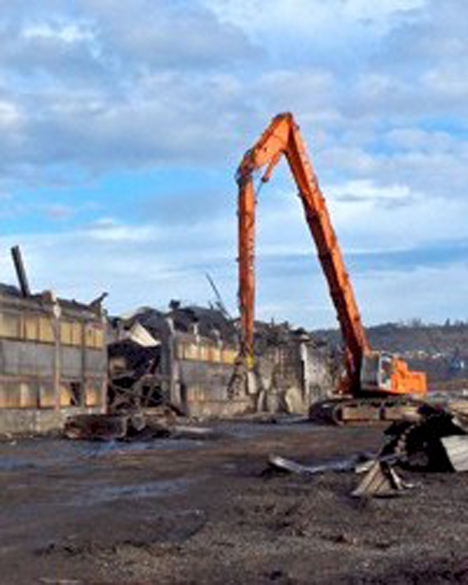One year ago, the 96-acre former Kaiser Aluminum site on the east side of the Blair Waterway was packed with the hulking ghosts of an old industry. More than 70 buildings and 16 other significant structures, including a 500-foot smokestack, comprised the remains of the old Kaiser Aluminum Smelter. Today, there’s nothing on the 96-acre site but bare dirt, a few old asphalt roads and a huge pile of crushed concrete. Eventually, the site will be integrated into the Port’s core maritime cargo business.
Originally built in 1941, the aluminum smelter had been expanded to a total of 740,000 square feet by 1980. According to Bill Evans, Port Project Manager, it took less than a year to demolish the plant, recycle the steel and other assets and dispose of waste.
Earlier phases of the project involved the removal and recycling of equipment and the collection and proper disposal of tons of oil, old paint, lab chemicals and miscellaneous debris.
“Our work here was fairly straight forward,” Evans said. “The real achievement was planning the overall plant dismantling, including the demolition phase, into manageable-sized portions to maximize the volume of recyclable materials while carefully managing and minimizing the volume of wastes.” The recycling numbers, says Evans, are still being tallied, “but they are impressive. We were able to recycle more than 150 million pounds of various products, including steel, copper, aluminum, lead, concrete, alumina ore, oil and carbon anodes. Dismantling of the smelter also resulted in the proper management and disposal of nearly 40 million pounds of waste, including asbestos, PCB’s, dangerous waste and various classes of solid waste.”
Evans, a member of the Port’s Environmental Department, says the project created a myriad of challenges as workers faced often difficult conditions. “Cleaning, dismantling and demolition tasks took a huge amount of effort and the use of some very large equipment in extremely confined spaces,” he said. “Throughout the project, we maintained a high focus on worker health and safety, both from the standpoint of preventing chemical exposure and the physical hazards of working in this setting.”
Port staff collaborated with Tacoma Police, Tacoma Fire, contractors, subcontractors, and consultants on the project.
According to Evans, the site will next be raised with clean fill dirt – a process that should be complete by the close of 2007. “We continue to work with the Department of Ecology to finalize our environmental efforts at the site,” he said. “When we’re done, the property will be ready for the next phase of development. And that means the creation of many new, family-wage jobs for our region.”







